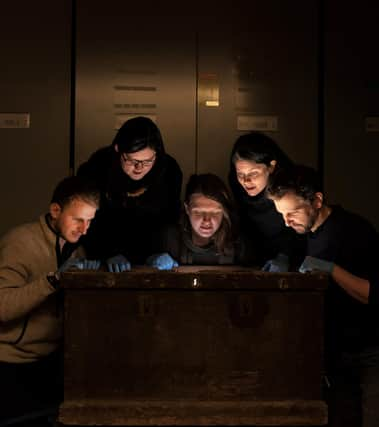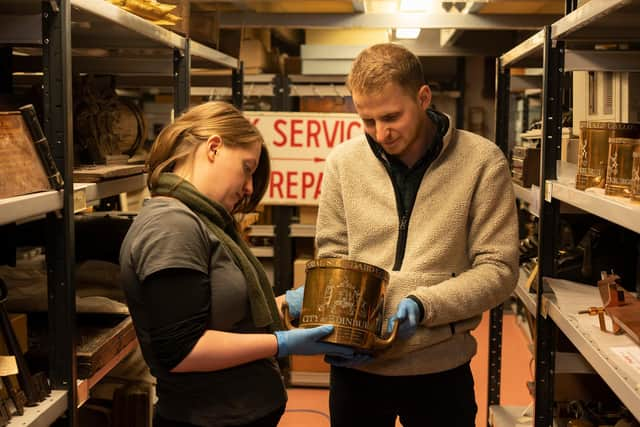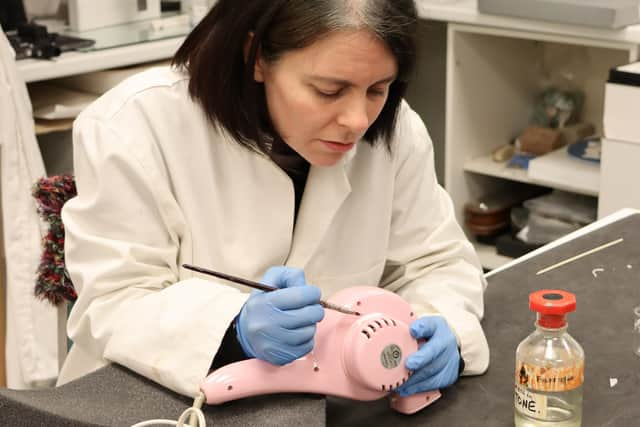Edinburgh's largest ever inventory project launched as Auld Reekie is retold


Over the course of three years, the project will see the recording and cataloguing of the collection of over 200,000 objects which are housed in stores and venues across the Capital in preparation for a move to a new store where those objects can be safely stored and effectively managed.
Auld Reekie Retold will also connect objects in the collection, which has been growing steadily since the 1870’s, with people and places in the city, uncovering new stories from Edinburgh and its residents.
Advertisement
Hide AdAdvertisement
Hide AdThe project will harness that public and professional knowledge about objects in the collection to share it with visitors, both in person at the museums and digitally throughout the project. That gathered knowledge and data will also be used to develop exhibitions and displays in the future.


Earlier this year, Museums & Galleries Edinburgh stood in solidarity with the #BlackLivesMatter movement and pledged to play an active role in standing up to racism. The project is an important opportunity for greater understanding of the origins of the collections and the way they have been catalogued.
The impact of Colonialism will be highlighted, seeking to educate and bring new perspectives and hidden stories to light. Future phases of the project will involve working with diverse communities across Edinburgh to record objects in new ways that better reflect today’s world.
Permanent museum staff have been joined for the project by three dedicated collections assistants whose work focuses on matching objects with any existing records, updating the information currently held and carrying out research.
Advertisement
Hide AdAdvertisement
Hide AdSome examples of stories and objects which have already come to light as part of work carried out prior to lockdown include a round metal stamp used for impressing on to wax, with the name and Trinity address of William Flockhart. Flockhart and his partner Duncan were surgeon apothecaries who produced a number of drugs and medicines in the 1840s. Among the customers on their books were James Young Simpson, the inventor of anaesthetics, and Florence Nightingale.


There is also a playbill printed on a 100,000 Deutschmark note for a play at the Lyceum Theatre entitled “Tons of Money”, staged in 1925, a time when hyper-inflation in Germany had reached a point where money was no longer worth the paper it was printed on. While people were paying for loaves of bread with wheelbarrows of cash, in Edinburgh, the bank note was used to advertise the ironically titled play.
The project will create a web of connections across the collections held by Museums & Galleries Edinburgh, from archaeology to social history. An example of this is the rediscovery of a small silver pendant of the Six Feet Club from the 1830s.
There were a number of secret and not-so-secret societies in Edinburgh at this time, each with its own particular niche interest or membership rule. This club was dedicated to athleticism, and to be a member you had to be a six foot tall man. Sir Walter Scott was made an honorary member despite not being six-foot-tall and left with a limp by a bout of childhood polio.
Advertisement
Hide AdAdvertisement
Hide AdSometimes the finds are a little closer to home, like the Ronson Escort 2000 Hairdryer from the 1970’s, designed to be used at home and worn like a satchel with a tube that connected to a shower cap style hood which would allow you to go about your day as you dried and set your hair and aimed at the modern women leaving her hands free to get on with her day, but from anecdotes from users it seems to imply it had varying results.
There will be a series of exhibitions hosted across the collection including Museum of Edinburgh, The Writers’ Museum and the Museum of Childhood, allowing visitors the opportunity to learn more about the various processes involved in maintaining the collection and to connect with objects, bringing them to life in the process.
While Covid restrictions are in place, these events will be online, but when visitors are welcomed back in to the museums, they will be able to see and handle real objects themselves. Information will also be made available digitally with regular updates, news and behind the scenes blogs and podcasts shared via the museum’s website and through social media using the hashtag #AuldReekieRetold.
Project Manager Nico Tyack said: “Auld Reekie Retold is a truly unique opportunity for Museums & Galleries Edinburgh to catch all the stories our collections can tell us about Edinburgh. From Jacobite muskets to life in tenements, Edinburgh Rock to Pride, medieval St. Giles to the Festival Fringe, we hope to spark conversations about our amazing collections and their hidden histories, gathering new insights for future generations to enjoy.”
Advertisement
Hide AdAdvertisement
Hide AdCouncillor Donald Wilson, Culture and Communities Convener, said: “We are lucky as a city to have this resource but at the moment much of it is hidden and inaccessible. This is very important behind the scenes work as we review how we currently meet the needs of our citizens and how we can better use our collections.
"I have long believed there is untapped potential in our collections and Auld Reekie Retold is allowing us to develop and gain a fuller understanding of what we have. By recording and cataloguing the collection of over 200,000 objects, it will also highlight those items that can be used for online resources and future exhibitions”.
A message from the Editor:
Thank you for reading this article. We're more reliant on your support than ever as the shift in consumer habits brought about by Coronavirus impacts our advertisers.
If you haven't already, please consider supporting our trusted, fact-checked journalism by taking out a digital subscription.
Comment Guidelines
National World encourages reader discussion on our stories. User feedback, insights and back-and-forth exchanges add a rich layer of context to reporting. Please review our Community Guidelines before commenting.